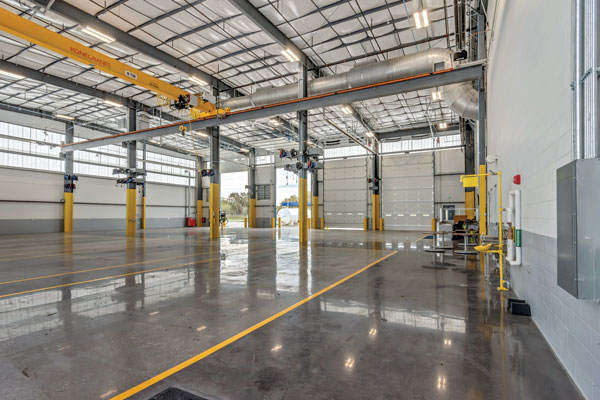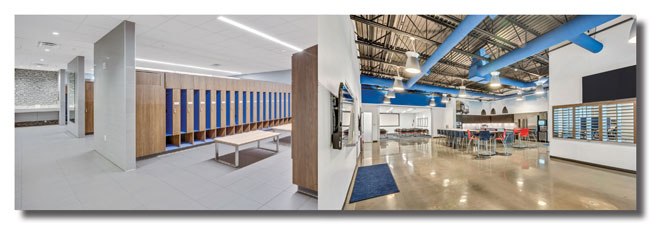Optimizing the investment made in your shop will directly correlate with the team of technicians you are able to attract, train and retain. The options for what you can do will vary widely based on the size, height, site space and ability to expand the current facility versus what you can do if you are building brand new.
By Jeff Eriks
As many of you know, it has become increasingly difficult to attract and retain technicians in today’s labor market. You must find ways to keep your existing employees from leaving you for another company and, at the same time, recruit new talent. This challenge extends beyond pay and benefits and goes directly to the work environment they are given, as well as the ability to get jobs done safely and efficiently. In this article, we will talk about ways to make your shop a more appealing environment to the staff you have and the people you are trying to hire.
We are often called to come out to existing facilities that are 20 years old. These shops have frequently been converted from warehouses or service stations, and we work with the owner to create an environment that their people like to work in.
Temperature Control
The maintenance facility itself needs to be comfortable, no matter the hours of the day the technician works. What is required will vary based on the location in the country. In the northern part of the U.S., you will want to make sure the facility can always stay above 55 to 60 degrees in the winter. Anything cooler than that and technicians will begin to lose hand dexterity, a leading cause of injury. The type of heat you put in your facility can range from in-floor radiant heat, which is the most successful at even temperatures throughout the shop, to radiant tube heating, or just make up air units that are ceiling mounted. Your budget and the type of work that you do will have a direct effect on the type of heat you install.
In the south, summer heat is an issue, so you will want to make sure you can maximize air flow throughout the facility at all times of day. Swamp coolers help, but there are other economical ways to keep the building cooler in the summer. The building envelope and insulation factors of the walls, ceilings and overhead doors make a difference, as well as making sure the building openings are shaded throughout the day using overhangs or awnings. Also, large ceiling fans that move a lot of air help tremendously.
Lighting
Commonly, waste facilities have afternoon and night shifts due to the nature of the work, thus requiring a well-lit shop, no matter how dark it is outside. This goes for the apron around the building and the truck parking areas too. The ability to see all around the equipment they are working on without having to carry a secondary light source is not only helpful for productivity, but also imperative to limit slip, trip and fall injuries. The type of light fixture is very important to determine for your space because the height off the floor needs to be factored in when specifying the light for your shop. The ability to maximize natural light during daylight hours will also provide a more even and powerful light. It is common in new facilities to have translucent panels on the walls or skylights to help bring in natural light for all parts of the shop area.

Employee Comfort Spaces
Technicians deserve a nice place to change their clothes, use the restroom, shower, take breaks and eat in. Creating an area that allows them to decompress before and after their shifts as well as a nice place to eat their lunch is very important. Nice locker rooms that allow them to get out of their dirty clothes before they head home is key as well. This is not a clean job and allowing them to leave their dirty uniforms at the facility and head out nice and clean goes a long way. Also, a break room where they can sit and relax, maybe watch some TV and get out of the noise and dirt of the shop is a huge plus. A clean breakroom where they can warm up food, store their items in a fridge, get ice for their water bottle and other similar items are a huge plus to keeping them happy.
Shop Amenities
Each shop will be different and needs to be evaluated based on what kind of work you will be asking your technicians to take on. If you remove engines, having a crane makes for a much safer work environment and one they will appreciate.
If you are doing body work, having a dedicated area for the welding and painting is great because it keeps those items out of the maintenance area. The welding area should have hoods that allow them to move them around and pull those fumes from the building immediately. Painting typically would be in a dedicated bay with a paint area or booth that meets local code requirements. Body work also requires many other types of equipment that must be planned into the overall facility, as placement and power requirements will be key to having an efficient operation.
For regular preventative maintenance, having a fluid distribution system throughout the shop is very convenient and safer. Allowing staff to simply pull down a hose from a reel hung overhead is much easier than moving around 55-gallon drums. Part of this system would also include lights with long cords, compressed air and water distributed throughout the space as well.
Proper power distribution for different types of equipment throughout the shop makes for less cords strewn around the shop that cause tripping hazards. Different types of outlets located in key positions make it much easier on the technicians to work on their vehicles.
Tool storage should be close by and in a safe location. Tools are a big investment for technicians, and making sure they keep them safe, clean and secure is a big deal.

Right: Breakroom.
Parts Storage
Companies are always balancing between the need to have sufficient parts on hand with having thousands of dollars in parts gathering dust. From the technicians’ perspective, they want to start and finish a job in a timely manner, so giving them the tools and parts required is important. Designing space for an appropriately stocked parts room with a parts window for work orders avoids unnecessary downtime in the shop while reducing write-downs for obsolete or misplaced inventory.
Technician Training
A thoughtfully designed shop creates a setting more conducive to technician training—a key element in employee retention. A well-lit and comfortable space, combined with a properly outfitted tool selection, will permit technicians to continue to add to their capabilities. Additionally, access to computers will encourage technicians to pursue online training courses, an increasingly popular and cost-effective approach to continuing education.
Wash Areas
Many of the vehicles that get worked on in these shops have been through a rigorous day out in the field. Having a dedicated wash bay so they can go clean off the engine, under the truck, inside the back, etc. makes a huge difference in shop morale. If technicians must dig out the mud and grime in their everyday work bay, leaving a huge mess on their floor, that is not something that makes them want to work there. However, if they have a dedicated bay where they can take equipment and pressure wash areas clean that they are going to work on, it is a huge help—they can see everything clearly and keep from bringing mud into the shop.
Optimizing Your Investment
Overall, the shop that you end up with can vary greatly, whether it is a brand-new building or one that is existing, and what parts you are going to upgrade. Optimizing the investment made in your shop will directly correlate with the team of technicians you are able to attract, train and retain. The options for what you can do will vary widely based on the size, height, site space and ability to expand of the current facility versus what you can do if you are building brand new.
Budget is always a factor as well. We always recommend that you bring in an expert who knows and understands the different facets of shops to help you design and build the new facility or to recommend upgrades for your existing one. The expert should supply you with options and pricing for each option so you can evaluate it internally and make educated decisions. The design-build expert teamed with your local maintenance manager and your other team members whether from corporate or ownership can all work together to decide exactly what should go into the facility to make you more intriguing for new hires and more appealing for current technicians. Spending the money to retain and attract talent is usually money well spent. | WA
Jeff Eriks is President at Cambridge Companies (Griffith, IN and Scottsdale, AZ), a design-build firm, working with the waste and trucking industries for more than 25 years. During this time, more than 170 solid waste design-build projects have been completed, including new build, repairs, upgrades and/or modifications at transfer stations, recycling centers/MRFs, hauling companies and maintenance facilities, landfill facilities, office buildings and more.
Cambridge continually monitors the industry to determine any new needs, changes or improvements that will benefit their clients and improve their design-build solutions. Jeff can be reached at (219) 972-1155, via e-mail at [email protected] or visit www.CambridgeCoInc.com.
